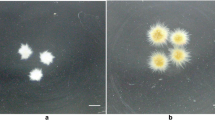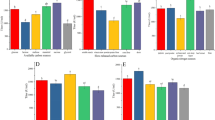Abstract
Beauvericin (BEA) is a cyclic hexadepsipeptide mycotoxin with notable phytotoxic and insecticidal activities. Fusarium redolens Dzf2 is a highly BEA-producing fungus isolated from a medicinal plant. The aim of the current study was to develop a simple and valid kinetic model for F. redolens Dzf2 mycelial growth and the optimal fed-batch operation for efficient BEA production. A modified Monod model with substrate (glucose) and product (BEA) inhibition was constructed based on the culture characteristics of F. redolens Dzf2 mycelia in a liquid medium. Model parameters were derived by simulation of the experimental data from batch culture. The model fitted closely with the experimental data over 20–50 g l−1 glucose concentration range in batch fermentation. The kinetic model together with the stoichiometric relationships for biomass, substrate and product was applied to predict the optimal feeding scheme for fed-batch fermentation, leading to 54% higher BEA yield (299 mg l−1) than in the batch culture (194 mg l−1). The modified Monod model incorporating substrate and product inhibition was proven adequate for describing the growth kinetics of F. redolens Dzf2 mycelial culture at suitable but not excessive initial glucose levels in batch and fed-batch cultures.


Similar content being viewed by others
References
Castlebury LA, Sutherland JB, Tanner LA, Henderson AL, Cerniglia CE (1999) Use of a bioassay to evaluate the toxicity of beauvericin to bacteria. World J Microbiol Biotechnol 15:119–121
Fiechter A, Seghezzi W (1992) Regulation of glucose metabolism in growing yeast cells. J Biotechnol 27:27–45
Fotso J, Leslie JF, Smith JS (2002) Production of beauvericin, moniliformin, fusaproliferin, and fumonisins B1, B2, and B3 by fifteen ex-type strains of Fusarium species. Appl Environ Microbiol 68:5195–5197
Grove JF, Pople M (1980) The insecticidal activity of beauvericin and the enniatin complex. Mycopathologia 70:103–105
Hamill RL, Higgens CE, Boaz HE, Gorman M (1969) The structure of beauvericin, a new depsipeptide antibiotic toxic to Artemia salina. Tetrahedron Lett 49:4255–4258
Jow G, Chou C, Chen B, Tsai J (2004) Beauvericin induces cytotoxic effects in human acute lymphoblastic leukemia cells through cytochrome c release, caspase 3 activation: the causative role of calcium. Cancer Lett 216:165–173
Lin HI, Lee YJ, Chen BF, Tsai MC, Lu JL, Chou CJ, Jow GM (2005) Involvement of Bcl-2 family, cytochrom c and caspase 3 in induction of apoptosis by beauvericin in human non-small cell lung cancer cells. Cancer Lett 230:248–259
Logrieco A, Moretti A, Castella G, Kostecki M, Golinski P, Ritieni A, Chelkowski J (1998) Beauvericin production by Fusarium species. Appl Environ Microbiol 64:3084–3088
Luedeking R, Piret EL (1959) A kinetic study of the lactic acid fermentation. Batch process at controlled pH. J Biochem Microb Technol Eng 1:393–412
Nilanonta C, Isaka M, Kittakoop P, Trakulnaleamsai S (2002) Precursor-directed biosynthesis of beauvericin analogs by the insect pathogenic fungus Paecilomyces tenuipes BCC 1614. Tetrahedron 58:3355–3360
Shuler ML, Kargi F (2002) Bioprocess engineering. Prentice Hall PTR. Upper Saddle River, NJ
Song HH, Lee HS, Jeong JH, Park HS, Lee C (2008) Diversity in beauvericin and enniatins H, I, and MK1688 by Fusarium oxysporum isolated from potato. Int J Food Microbiol 122:296–301
Xu LJ, Liu YS, Zhou LG, Wu JY (2010) Optimization of a liquid medium for beauvericin production in Fusarium redolens Dzf2 mycelial culture. Biotechnol Bioprocess Eng (accepted)
Xu LJ, Zhou LG, Zhao JL, Li J, Li X, Wang J (2008) Fungal endophytes from Dioscorea zingiberensis rhizomes and their antibacterial activity. Lett Appl Microbiol 46:68–72
Acknowledgments
This work was supported by The Hong Kong Polytechnic University (grants G-U502 and G-YG12) and the Hi-Tech Research and Development Program of China (2006AA10A209).
Author information
Authors and Affiliations
Corresponding authors
Electronic supplementary material
Below is the link to the electronic supplementary material.
Rights and permissions
About this article
Cite this article
Xu, LJ., Liu, YS., Zhou, LG. et al. Modeling of Fusarium redolens Dzf2 mycelial growth kinetics and optimal fed-batch fermentation for beauvericin production. J Ind Microbiol Biotechnol 38, 1187–1192 (2011). https://doi.org/10.1007/s10295-010-0895-2
Received:
Accepted:
Published:
Issue Date:
DOI: https://doi.org/10.1007/s10295-010-0895-2




